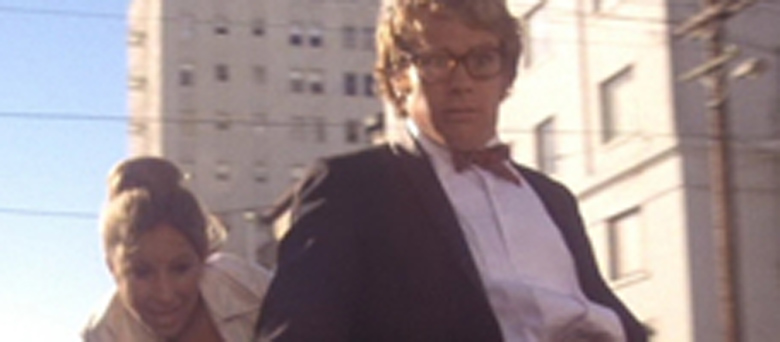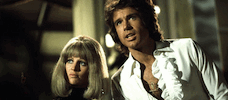Reviews
Peter Bogdanovich
USA, 1972
Credits
Review by Evan Kindley
Posted on 19 May 2010
Source Warner Brothers DVD
Categories Seventies Screwball
Before we get into the film itself (you’ve got time, right?), it might be interesting to take a look at some of the vintage publicity materials for What’s Up, Doc?, conveniently archived for us on Warner Brothers’ DVD. A promotional featurette called “Screwball Comedies… Remember Them?” begins by laying the nostalgia on with a trowel: “Do you remember the great old days of screwball comedy? Well, they’re back.” Well, sort of: the screwball spirit is not so much revived as painstakingly reconstructed by the dutiful young Peter Bogdanovich, who has spent “thousands of hours” studying the models of Ernst Lubitsch, Leo McCarey, Frank Capra and Howard Hawks in order to bring us a perfect simulacrum. While Bogdanovich’s cinema scholarship, then as now, is impressive, treating the screwball genre with so much academic respect sort of misses the point, and runs the risk of losing the lightness and charm that are the reason people loved these comedies in the first place.
All this to say that What’s Up, Doc? is a pretty calculated movie, and while it’s also a pretty funny one, it lacks the apparently effortless grace of the great 30s screwballs it borrows from. The film is often considered a tribute to Hawks’ evergreen Bringing Up Baby, starring Katherine Hepburn and Cary Grant, and Ryan O’Neal’s distractable archaeologist Howard Bannister is indeed very close to Grant’s similarly absent paleontologist. They both have business-minded, dominating wives (Virginia Walker’s Miss Swallow in Baby, Madeline Kahn’s Eunice in Doc) and both are anxious to get in the good graces of powerful philanthropists: Mr. Peabody in Baby, Frederick Larrabee in Doc. Finally, both are pursued by energetic, enterprising young women: Hepburn in Baby, Barbra Streisand in Doc. As in the original, Streisand - here playing a perpetual college student named Judy Maxwell - finds ways to continually put herself in Howard’s path, despite his obvious annoyance.
So far so Hawksian, but Bogdanovich actually ranges pretty far afield in his search for inspirations here, evoking the Marx Brothers or Frank Tashlin at least as often as he does Hawks or McCarey or Capra. (An early gag in which a pizza chef throws dough in the air and it doesn’t come down is pure Tashlin.) The mode of What’s Up, Doc? is arguably more farce than screwball: the plot hinges on the coincidence of four identical plaid overnight cases (one containing diamonds, one top secret files, one igneous rocks, and one clothing) which lets Bogdanovich do some fancy Hitchcockian prestidigitation, far more intricate than anything Hawks ever did. Much depends on elaborate setups that spiral into out-and-out chaos, like a hotel room catching on fire or a hectic fight scene, complete with a couple of good old-fashioned cream pies in the face. The pièce de resistance is a crazy chase sequence on the streets of San Francisco, in which Howard and Judy somehow end up commandeering a Chinese dragon float. A lot of this is actually closer to sixties comedies like It’s A Mad, Mad, Mad, Mad World than it is the comedies of remarriage that Bogdanovich values so highly.
Most important, the emotional tone of What’s Up, Doc? is more determinedly anti-sentimental than its 30s predecessors. Buck Henry, David Newman and Robert Benton’s script takes care to undercut any genuine romantic moment before it can get too convincing - a sly move given that Streisand was then already knee-deep in schmaltz and O’Neal was best known for starring in the decidedly goopy Love Story (whose tagline is parodied in an exchange towards the end of the film: “Love means never having to say you’re sorry.” “That’s the dumbest thing I ever heard.”) Where the moments I tend to remember from Bringing Up Baby are actually quite tender ones - like Hepburn telling Grant “You are so good looking without your glasses” - the best lines in Doc are the outright silliest, as when Eunice asks Howard why he’s drawn a bubble bath and he answers, “It came out of the faucet that way.” The title’s homage à Looney Toons casts Streisand in the Bugs Bunny part, an allusion that both desexualizes her and sets her up as more of a tormentor than a suitor, an emphasis which upsets the perfect balance of Bringing Up Baby, where Hepburn is both tormenting Grant and pursuing him, helpless to do one without doing the other. By contrast, Streisand’s Judy seems perfectly in control at all times, sadistically toying with Howard like Bugs with Elmer.
If O’Neal and Streisand - who are both, by the way, distractingly tan - don’t have anything like the natural chemistry of Grant and Hepburn, they’re helped out by a lot of ace character actors filling in the gaps, including Kenneth Mars as a pompous Croatian musicologist, the rodent-like Austin Pendleton as Mr. Larrabee, an unbelievably young Randy Quaid as… somebody or other, and Liam Dunn as a weary, dyspeptic judge. (Also look for a brief appearance by M. Emmett Walsh as a bailiff in the courtroom scene.) The highlight, though, is Kahn, who despite having the straight woman role schools Streisand in comic timing. (I often found myself wishing their roles had been reversed.) Warming up for much brassier turns in Mel Brooks’ Blazing Saddles, Young Frankenstein, and High Anxiety, Kahn gives Eunice a puzzled vulnerability not really required by the film’s logic, but welcome in a film where everybody else are somewhere in the vicinity of grotesque.
What does it say about the seventies that screwball comedy was briefly in fashion again? Probably not all that much, to be honest; the precocious movie brats who populated the New Hollywood retrofitted any number of old genres, after all, from the gangster film to the Western. But they usually did so in the name of high art, borrowing techniques and themes from European masters like Antonioni and Godard to justify working with these old, hackneyed forms. Bogdanovich doesn’t go this route; in that featurette, the studio insists on their resident auteur’s essential unpretentiousness: “Bogdanovich doesn’t try for the obscure or self-conscious in his films. He lays it out neat and clean, and lets the audience have their own entertainment and fun.” So maybe the neo-screwball trend reflected a nostalgia for a cinematic populism that Bogdanovich can’t quite manage on his own; or, more cynically, a real bid for mass success. (It should be noted that What’s Up, Doc? was an enormous hit - the biggest of Bogdanovich’s career.) But the New Hollywood also prided itself on being radically different from the Old, as Peter Biskind’s Easy Riders and Raging Bulls and Ted Demme and Richard LaGravenese’s A Decade Under the Influence have recently reminded us. In the trailer for What’s Up, Doc? (also included on the DVD) we’re told of the “utterly new and different atmosphere created on the Bogdanovich set. No more the crass showmanship and slapdash of the old Hollywood. Here too, none of the catch-as-catch-can, do-it-anyway attitudes of former filmmakers. Here instead is a skilled artist, sophisticated in his craft, using the camera as Heifetz uses a Stradivarius.” OK, my irony alarm is going off now, you screwballs you; were Bogdanovich and Warner Brothers satirizing the revolutionary claims of the New Hollywood? Was the screwball revival a way to have the whiz-kid auteur cake and eat it (in the form of commercial profits) too? Was Bogdanovich trying to tell the New Hollywood not to take itself too seriously, albeit in a seriously studious way, by invoking no less a Film Authority than Hawks? What’s Up, Doc?, for all its small pleasures, has the feel of a party joke delivered like a term paper.
More Seventies Screwball
We don’t do comments anymore, but you may contact us here or find us on Twitter or Facebook.








